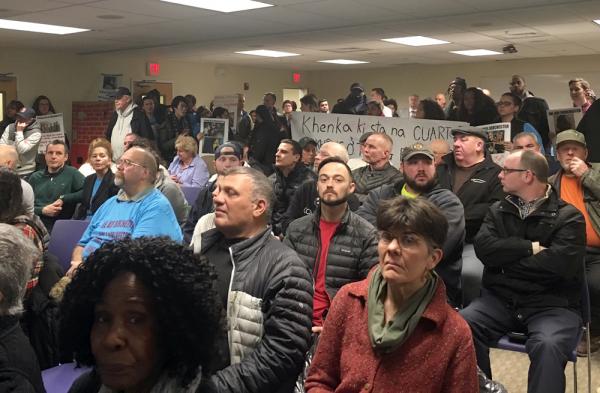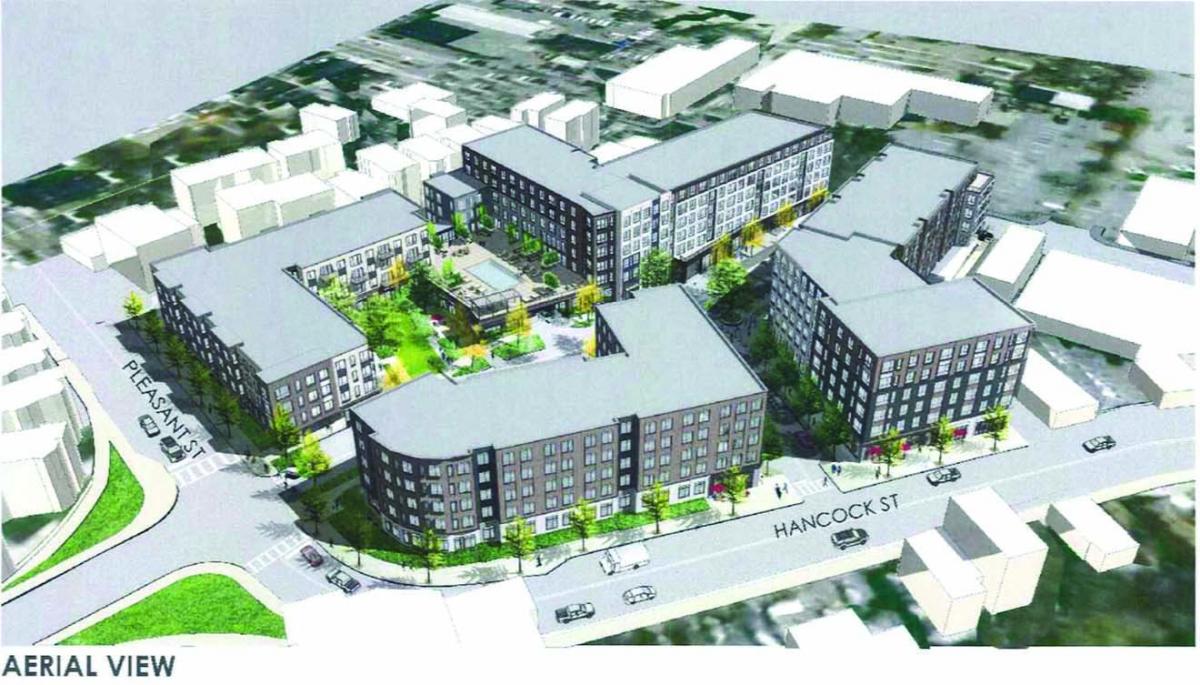February 13, 2019

More than 150 people packed into a public meeting for the Dot Block development on Monday evening, with heavy representation from local civic groups, building unions, and the pro-affordable housing and anti-displacement group Dorchester Not For Sale.
After a presentation on the proposed 488-unit, four-building Glover’s Corner project, dozens lined up inside the Work Inc. building on Beach Street to offer feedback, almost all offering their Dorchester resident bona fides and history living in the neighborhood before commenting. The 4-acre site, which was cleared after a demolition project last year, sits within the bounds of Dorchester Avenue and Greenmount, Pleasant, and Hancock streets.
Many from the Dorchester Not For Sale (DN4S) group said the 66 affordable units were insufficient, not geared toward families, and would effectively push residents out of the neighborhoods. Civic members were generally supportive of the plan as a whole and noted that the parcel itself has long been blighted industrial space. But some were displeased that an earlier promise of a supermarket has been jettisoned in favor of smaller “neighborhood retail” spaces. Union contractors applauded the development as a job opportunity and an opportunity to clean up the block.
Mimi Ramos, director of the Dorchester-based advocacy group New England United for Justice, said, “Even if you said 70 [units], out of 488 coming in, that is not enough. We have been steadily paying attention to who lives in the community, what the income for real is in our neighborhoods, and this is not housing for us. You are blatantly telling the community we do not want you here, blatantly telling the community that this housing is not for the residents who currently live here.”
The development team is proposing around 20 percent of the apartments as compact units. Abe Menzin, Executive Vice President at Samuels & Associates, collaborating with Gerald Chan’s Wintergold LLC, said there are 24 units being offered at affordability levels below the Inclusionary Development Policy requirement of 70 percent area median income, including 45 percent, 50 percent, and 63 percent area median income options distributed proportionally across the varying types of units.
“We’ve heard that traditional affordable pricing points don’t work for everyone in this neighborhood,” he said.
To that end, they are also instating a neighborhood diversity preservation program, where half of the units would give priority to people living within three quarters of a mile from the project.
“The things we struggle with, and I know there are people here who are not happy with the levels of affordability that we’re providing,” Menzin said during his presentation. “Honestly, I wish we could provide more.”
A chorus of voices from the edges of the room interrupted with “you can.”
Menzin continued, “The challenges we have with affordable housing right now: the cost is enormous. The construction costs in the city prevent us from being able to build more affordable housing. There’s almost no subsidy available.”
Low income housing tax credits are capped, he said, and the 66 units they are proposing is about equal to the number of affordable units that have been constructed through the IDP program in Dorchester so far.
Diane Shepherd felt that the unit composition, with studio through three-bedroom apartments, was out of step with the surrounding area. Three-deckers, for instance, she said, represented “diversity and families, and I don’t see that in this. I see what someone else mentioned: You’re out. Students? One child? Anything else, you're not welcome here, this is not for you. I fear that you’ll change the face of Dorchester.”

The Dot Block project has been in development in various forms since 2012. After winning initial approval from the Boston Planning and Development Agency in May 2016, it began a redesign process when billionaire Gerald Chan purchased the parcel as the new primary investor that winter.
In its new iteration, the unit count is up from 362 to 488, and a 345-space underground parking garage would open up the site for more green space and better pass throughs from Hancock Street to Dorchester Avenue. Retail space shrank considerably, now about 23,000 square feet.
“At a time when construction costs are sky high and the population of greater Boston is growing, we are at risk of underproducing housing of all types and prices,” Menzin said in a statement. “The Dot Block not only adds a range of new housing product into the market, it exceeds affordability goals set by the city in terms of number of affordable units and depth of affordability.”
Monday was the first city-hosted meeting for the project since the latest change. It marked first time that the DN4S had an arena to weigh in on Dot Block since they formed in 2017 in part because of a new planning study for the Glover’s Corner village.
As Eric Robinson of RODE Architects — the original architectural firm for the project that is no longer part of the development team— pointed out that there were 110 public meetings during the first four years of the planning process alone.
“This was a project that was for the neighborhood, through the neighborhood, with the neighborhood, and I was at every single one of those meetings, so I’m gonna take a little bit of exception to that people didn’t know about the project,” said Robinson. “But now’s a different time and the project’s at a different place.”
He encouraged everyone at the meeting to submit comments to the city.
“Your voice matters,” Robinson said. “I supported the project day one and I support it now… not every project is gonna be perfect for everybody, we do work all over the city, but please make your voice heard.”
Union carpenter Desmond Owens, a Fields Corner native, was one of a handful who looked forward to the jobs that will be created by the development.
“I love the project honest to God, I really do,” said Owens. The site, he and others said, has been a troubled spot. “This corner has been an eyesore for years,” he said.
George Kelly echoed the comment, saying “that place was dog and pony show for years. I think it’s gonna be an asset to the community, this project.”
Some locals acknowledged the worries but were optimistic. Michael Keamy said, "there’s a lot of concern and a lot of fear, and I think a lot of it is legitimate, but I think you can create something that’s beautiful. It's going to trickle through the neighborhood, and I think it’s going to make everything better for everybody."
Local attorney Stuart Schrier was among those upset by the lack of supermarket and worried about traffic.

“We need housing and this is a good thing to build, but we were told there was gonna be a supermarket there,” he said. “The problem when you take away the supermarket is that 488 families are going to be leaving the site to drive down to Morrissey Boulevard or to South Bay to get groceries....You’re creating a traffic nightmare when you told us there would be a grocery store there, and we need that grocery store.”
He concluded, “You promised it to us and now you’re taking it away.”
Menzin said they were not part of the original project team and he could not speak to the commitments made at the time.
Though the project is “beautiful,” Erica Schwartz worried that the compact units and estimated cost of $4 a square foot would cause “a devastating ripple effect” on home prices and possibly the local commercial prices.
Shirley Jones of Meetinghouse Hill Civic Association said she did not want to look out of her window and see brick facades. Walking up to the front of the room, she pointed at the small model of the site at the little cardboard space where her house would be.
“Brick, brick, brick,” she said. “I’m not against affordable housing. I’m not against making this area a dynamic place for people to live, which I know will happen, but what I am not in favor if is having all of my view taken away.”
Ramos was the first of several who decried the lack of translation services provided.
“You spoke highly about diversity and culture, yet it is a disrespect that we do not have interpretation here for our community,” she said, calling out her comment from the crowd. “If we did not bring our own interpretation, folks who are here who are not English speakers wouldn’t be able to understand what this project means.”
Menzin said they do not typically provide translators and it was a city-hosted meeting.
The 30-day BPDA comment period for the change of project ends on March 1. Some at the meeting expressed annoyance at the short notice of Monday night’s meeting, though BPDA project manager Aisling Kerr pointed out that they wanted to have the public forum before February vacation week and with enough time before the comment period concludes for community members to consider the proposal, confer, and submit comments
Some at the meeting called for further gatherings to discuss Dot Block. Menzin said they have been trying to coordinate with the DN4S group to be on their meeting agenda.
“We’re delighted to meet with anybody, any time, anywhere,” said spokeswoman Catherine O’Neill said on Tuesday. “If there's going to be another BPDA meeting, that’s not our call, that’s the city’s call. We intend to meet with Dot Not For Sale. We’ve been seeking a meeting with Dot Not For Sale for over month, and we believe they’ll have us on their agenda at some point.”
(Editor's note: The original version of the article a misattributed a quote to a different Savin Hill resident. We regret the error.)
The Dot Block project page can be found here. Jennifer Smith can be reached at jennifer.smith@dotnews.com, or follow her on Twitter at @JennDotSmith


